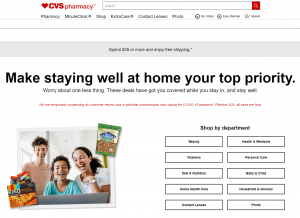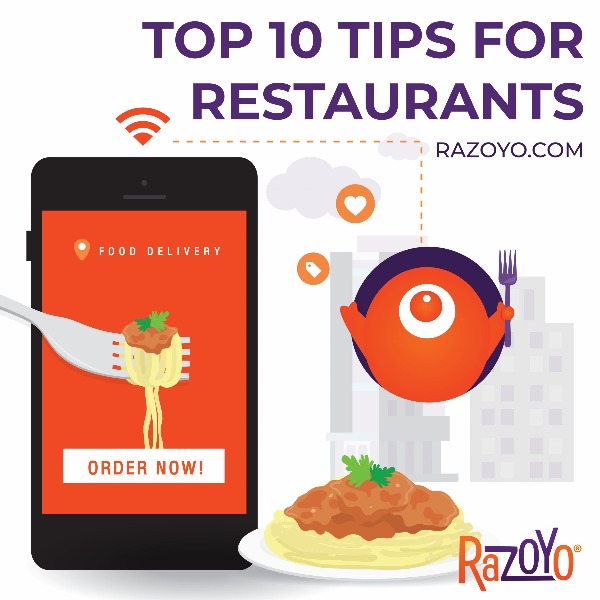
Top 10 Things e-Commerce Retailers Can Learn From COVID-19
April 29, 2020 by Emily Norniella
In order to successfully survive this pandemic as e-commerce merchants, there is much to be learned by examining how others are adapting: from transforming their marketing strategies, to prioritizing customer needs, and even to just keeping their website’s information as up-to-date as possible. Let’s dive into the Top 10 Things e-Commerce Retailers Can Learn from COVID-19.
1. Make the first options on your website count
Many retailers are changing the options on their website to help display items that people are frantically searching for. This can be done by adding quick links at the top of their website, or by including banners on their front page! Here are some example of retailers pushing high-demand items on the front page of their websites:
Example 1) CVS.com has prioritized certain departments to help customers search and purchase specific items quicker and more efficiently.

Example 2) A client of ours, Modmart.com, has added COVID essential items, like hand sanitizer and masks, to their inventory in response to the pandemic. To make sure their customers are aware of the new products, they adjusted their navigation bar to showcase these items, allowing customers to easily find and order these products.
2. Look into other online sales channels
With Amazon deprioritizing shipping for non-essential items, now is the perfect chance to switch up your inventory and offer a wider variety of selling channels. Customers are searching far and wide for a variety of different products and they aren’t limiting themselves to big name’s like Walmart and Ebay anymore. Expanding your channels is a great way to reach both your existing customers and attract new ones.
3. Take the time to communicate with your customers
Simply creating a section to inform customers about how they can order items and what to expect during this uncertain time can also be incredibly beneficial to your e-commerce site.
Allowing customers to get immediate responses from your brand is a crucial tool to use in these current times and will save you time as business picks up again. Olark or Zendesk for free when you sign-up for an account.
Though setting up a chatbot requires some time, the investment will pay off when the bot can quickly respond to frequent customer messages with your personalized responses.
4. Take advantage of FREE advertising opportunities
Admit it. Everyone loves free stuff! Google is now offering free Google Ads (sort-of), allowing you to get your products in front of even more potential customers. It is important to note that to participate in the Google Surface program, you must have the appropriate markup on your product pages.
Getting your pages to be set up for the free Google product search results is something Razoyo can help you with. Learn more.
5. Think outside of the box!
There’s no better way to gain repeat customers than to offer a unique or rare service. For instance, small businesses may be able to provide a no-contact curbside pick-up site for customers to receive their products on their own time. Or create a locker system for customers to pick up their products, like this New Jersey board-game business.
6. Meet Customer Demands
Customers are on the hunt for the best deals now more than ever before. Waiving shipping/delivery fees can entice customers to purchase from your store, simply because it saves them a few dollars and makes you stand out from the crowd of other retailers who aren’t offering the same discount.
7. Make use of SEO terms
Toiletry and bath items? Cleaning supplies? What are most people searching for currently? These trends can help drive more traffic to your site. Updating your search engine terms is a smart way to get your business to the forefront of customer searches! Here are some great tips for updating your SEO.
8. Consider selling bulk inventory
Once businesses start inevitably opening back up, many owners are going to be on the hunt for items like tissues, hand sanitizer, soap, even no-contact thermometers, etc to supply their offices. Consider advertising these items as “available in bulk” to additionally push B2B sales.
9. Offer a Subscription Service
Offering subscription services to customers creates consistent sales, returning customers, and ultimately provides a huge amount of customer convenience.
For example,there are certain items (laundry detergent, water, etc.) that many customers need refills on every month or so. Offering a subscription for these kind products can create an essentially automatic revenue stream, just take a look at how sites like BarkBox.com and Imperfect Foods utilize auto-shipping features.
Take a look at platforms like OrderGroove and Rebilia if you’re interested in setting up a subscription for your own site!
10. Call Razoyo
Clearly we think that scheduling a consultation with us is always beneficial for your e-commerce site, but it’s especially helpful to have expert advice in times like these when your online experience is exponentially more valuable.
We can help set up custom integrations to make these changes as easy and as affordable as possible for your business! After all, 25% of customers turn away because a website doesn’t have enough information or isn’t user friendly, so let us help!





